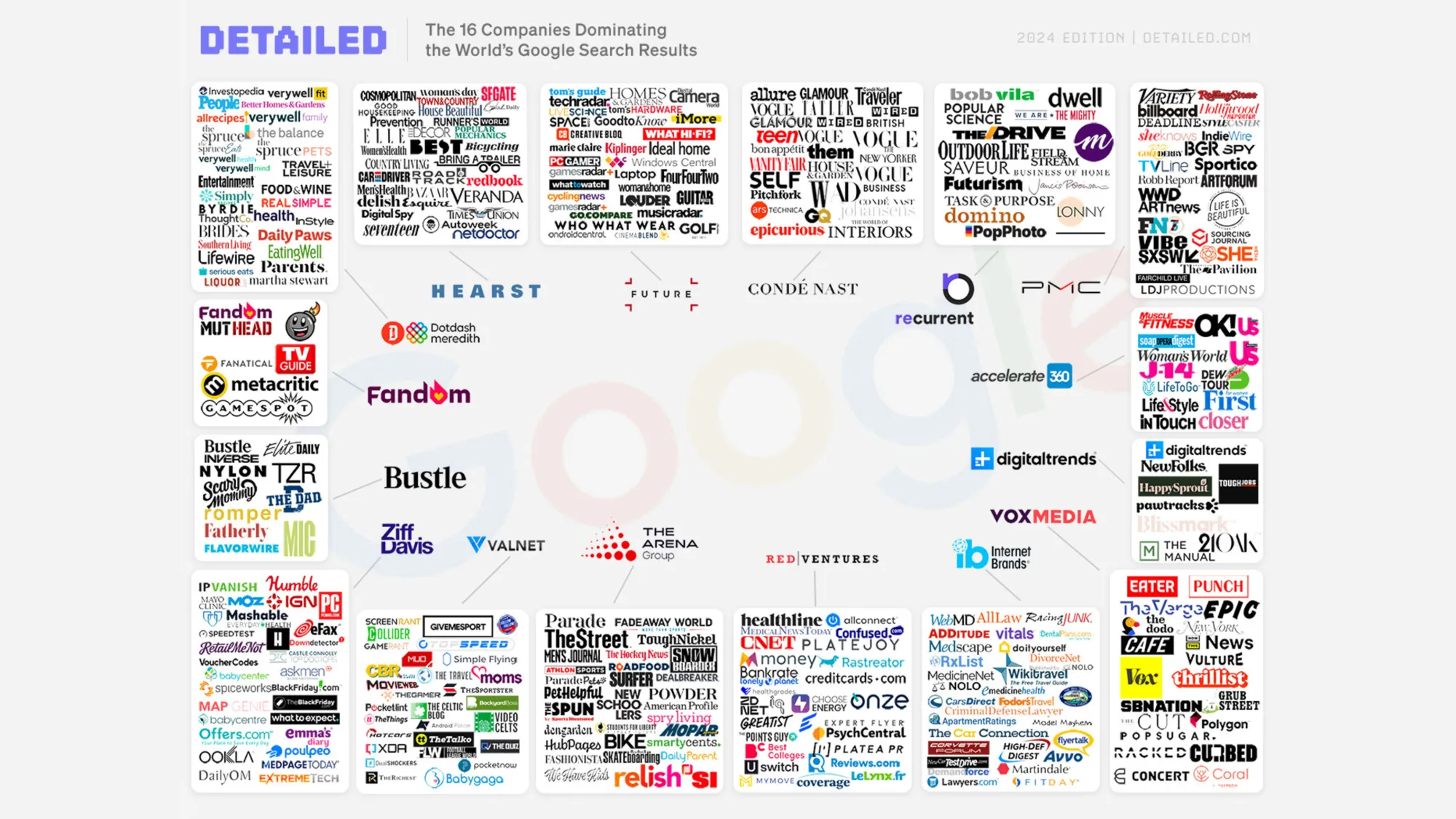Publisher spends $200,000 trying to recover from Google algorithm changes
Australian lifestyle publication documents three-year journey through Google's Helpful Content Update impacts.

A detailed case study published 14 days ago reveals the extensive efforts and financial costs incurred by independent publishers attempting to recover from Google's algorithm changes. DMARGE, an Australian men's lifestyle publication operating since 2009, documented their comprehensive recovery attempts following traffic losses attributed to Google's Helpful Content Update implementation.
Get the PPC Land newsletter ✉️ for more like this
According to the case study, the publication experienced a dramatic decline from eight million monthly unique visitors to 300,000 following algorithm changes that began with the November 2021 Core Update and intensified with the Helpful Content Update rollout. The website, which employed a 10-person editorial team covering watches, cars, food, and travel content, saw no manual actions or warnings from Google during this period.
The financial commitment to recovery efforts reached significant proportions. According to the documentation, SEO consultants cost $25,000, web development changes totaled $120,000, and content creation and editing required $75,000. Additional calculations factoring in owner time at $100 per hour over three years brought total costs to approximately $295,000, though the headline figure of $200,000 represents direct monetary expenditure.
SEO consultant Lily Ray provided recommendations during the recovery process for $600 per hour. According to the case study, her suggestions included making categories more granular rather than broader, auditing every URL using multiple data sources, strengthening internal linking systems, adding text content to video-heavy pages, and submitting different site sections to Google Publisher Center separately. Ray also recommended removing or isolating content that could be classified as not safe for work, as this material could potentially impact the entire domain's performance.

The publisher implemented comprehensive content modifications over multiple years. According to the documentation, these efforts included removing articles under 200 words, stripping embed-heavy content that relied primarily on third-party media, cutting quote-padded news stories, and implementing extensive editorial structure improvements. The website deleted all tag pages, brought in subject matter experts including fashion stylists and car journalists, and completely removed entire content categories such as style, sport, grooming, food, and entertainment in an attempt to narrow their topical focus.
Technical optimization efforts proved equally extensive. According to the case study, the team invested $60,000 to $70,000 annually in development work, testing everything from permalink structures and server configurations to Core Web Vitals optimization. They modified their URL structure to include subdirectories for content categories, creating thousands of redirects across the site. The publisher also experimented with content publishing frequency, testing various schedules from eight stories daily for three days per week to single daily publications.
The competitive analysis revealed inconsistencies in how similar websites performed across Google's various platforms. According to the documentation, sites with comparable content strategies experienced vastly different visibility levels in Google Discover and Google News, leading to investigations into potential causes including affiliate content focus and backlink profiles. The publisher's 15-year backlink profile included links from Bloomberg, CNN, The Guardian, Business Insider, and Wikipedia, yet this established authority appeared insufficient for recovery.
Health-related content removal represented another significant modification attempt. According to the case study, the publisher removed their entire health section containing 2,000 articles focused on fitness and mental health for men, despite contributions from trainers and doctors. They also systematically removed profanity and potentially flagged terminology from thousands of articles, along with fitness imagery that could be classified as inappropriate.
Revenue implications extended beyond traffic metrics. According to the documentation, programmatic advertising revenue dropped to 3-5% of previous levels, making continued investment in quality journalism financially challenging. The publisher noted that reduced display advertising income eventually necessitated editorial staff reductions and content quality compromises.
Google's public statements during this period acknowledged some issues with the Helpful Content Update's implementation. According to industry reports, Danny Sullivan admitted at creator summits that affected publishers were producing quality content despite ranking drops, describing this as "an interesting admission that the Helpful Content Update negatively impacted certain sites in ways other than what Google likely initially intended."
The publisher's analysis of Google Discover content during their recovery period revealed concerning patterns. According to the case study, while they removed carefully written journalism, Google Discover continued featuring content classified as spam, AI-generated material, clickbait headlines, and content from sites with fake author profiles. This observation undermined confidence in the platform's commitment to promoting helpful content over engagement-driven material.
Current website status reflects the limited success of recovery efforts. According to the documentation, DMARGE reduced from 12,000 articles across multiple lifestyle categories to 3,000 articles focused exclusively on watches, cars, and business travel. The publisher expressed confusion about how extensive optimization efforts and editorial precision could yield zero improvement in search visibility.
The broader implications for independent publishing emerge clearly from this case study. According to the documentation, the experience removed the motivation for breaking news cycles and identifying significant stories, as reduced visibility made such efforts commercially unviable. The publisher noted that Instagram and newsletter distribution now provide better reach than website publication for their content.
Industry expert commentary supports the documented challenges. According to reports, SEO consultant Barry Adams confirmed that the website appeared technically sound with no apparent reasons for algorithmic penalties. The Google News Initiative, designed to support journalism, provided limited assistance beyond standard documentation recommendations and vague engineering escalation promises.
Recovery timeline analysis indicates that meaningful improvements remain elusive for many affected publishers. According to recent industry research, sites impacted by the Helpful Content Update show limited recovery signs even after multiple subsequent algorithm updates. The documentation suggests that Google's current focus on e-commerce and artificial intelligence integration may have shifted priorities away from traditional news and lifestyle content evaluation.
The case study's conclusion emphasizes the unpredictable nature of current search algorithm behavior. According to the publisher's assessment, Google appears to operate without consistent rule application, creating an uneven competitive landscape where newer sites with allegedly weaker content can outperform established publications with extensive authority in specific categories. The publisher maintained first-to-market positioning in their coverage areas yet failed to achieve recognized expertise status for topics like watches, despite 15 years of specialized coverage and annual industry event attendance.
Technical SEO investment outcomes particularly highlight the challenge's complexity. According to the documentation, despite implementing textbook optimization practices and achieving excellent Core Web Vitals scores, technical improvements produced no measurable search performance benefits. This finding contradicts traditional SEO wisdom that technical excellence forms the foundation for ranking improvements.
The marketing community faces several implications from these findings. First, the unpredictability of algorithm changes suggests that heavy SEO investment may not guarantee recovery or protection from future updates. Second, the apparent preference for brand authority signals over content quality metrics indicates that reputation building and direct audience relationships require greater emphasis in marketing strategies.
Third, the documented ineffectiveness of traditional optimization approaches suggests that marketers should diversify traffic acquisition methods rather than relying primarily on organic search visibility. Fourth, the cost analysis reveals that recovery attempts can consume substantial resources without guaranteed results, making careful budget allocation crucial for sustainable operations.
Finally, the case study demonstrates that even extensive expert consultation and implementation of recommended best practices may prove insufficient for algorithm recovery. This reality requires marketers to balance optimization efforts with alternative growth strategies that provide more predictable returns on investment.
Get the PPC Land newsletter ✉️ for more like this
Timeline
November 2021: DMARGE begins experiencing traffic decline with Google's Core Update
August 2022: Google announces Helpful Content Update targeting AI-generated content
September 2023: Major Helpful Content Update rollout causes widespread publisher traffic losses
Late 2023: DMARGE traffic drops from 8 million to 300,000 monthly visitors 2024: Publisher invests $200,000+ in recovery efforts including consultant fees and technical modifications
March 2024: Google implements core update, many affected sites experience additional losses
August 2024: Google's core update aims to better reward small publishers, limited recovery documented
October 2024: Google hosts Web Creator Summit, acknowledging system limitations in recognizing quality content
November 2024: Google announces upcoming Helpful Content system updates
December 2024: Spanish automotive site Test Coches reports 90% traffic loss, industry experts warn of continued small publisher challenges
May 11, 2025: DMARGE publishes comprehensive case study documenting failed recovery attempts
Related Coverage
- Google search updates risk damaging independent publishers, experts warn - December 15, 2024
- Test Coches loses 3 million monthly readers after Google algorithm change - December 25, 2024
- Google's Web Creator Summit reveals challenges in Helpful Content system detection - November 1, 2024
- Open letter to Google reveals challenges faced by Small Publishers post-updates - September 8, 2024
- Google's HCU: Brand signals may play larger role than expected - September 8, 2024
- Google's August 2024 Core Update: small publishers in the spotlight - September 7, 2024


